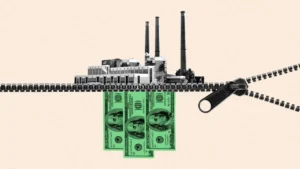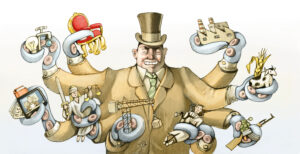The Insider’s Economic Dictionary: F Is for FIRE Sector
Free markets: Markets dominated by the financial and propertied classes whose objective is to secure all discretionary income for themselves, ultimately by asset stripping, leaving the economy without freedom of choice except to pay the rentier class.
By Michael HudsonThis piece first appeared at the website of University of Missouri, Kansas City economics professor Michael Hudson. Read the rest of the Insider’s Economic Dictionary here.Factoid
: A hypothesis, rumor or story so consonant with peoples’ preconceptions that it is accepted as a fact or working assumption, even though it often is made up a priori. Among the most notorious examples are the ideas of diminishing returns, equilibrium, that privatized ownership is inherently more efficient than public management, and that trickle-down economics works. (See Junk Science.)
Factor of production: Labor and capital are the two basic factors of production, creating value. Many classical economists also treated land as a factor of production, but it is rather a property right. It is needed for production, like air, but as a legal right it becomes an institutional opportunity to charge rent, via a legal claim permitting landlords to levy a toll for access to a given site. In this respect air, water, technology, patents and similar inputs are not strictly speaking factors of production, which involve costs that ultimately are reducible to labor inputs. Interest-bearing debt claims hardly can be treated as a payment to a “factor of production,” as if they were an inherent part of the production process.
Fallacy, economic: Economic fallacies are often generated by language coinage in the political arena and the popular press to be carried forward into subsequent eras. For example, S. Dana Horton pointed out in his Silver and Gold (1895) that “The fallacies that lurk in words are the quicksands of theory; and as the conduct of nations is built on theory, the correction of word-fallacies is the never-ending labor of Science. … the party in this country, one of whose great aims was, at one time, the perpetuation of slavery, owed much of its popular vote to the name Democracy.” Like so many public relations and lobbying efforts in the present era, seemingly bland economic and business characterizations can stultify generations of economic thought.
Falling rate of profit: In Marxist economics, profits were expected to decline as production became more capital intensive, leading depreciation (a return of the capital invested, in contrast to a return on capital) to rise as a proportion of overall cash flow. Strictly speaking, this did not mean that profit rates as such would fall, merely that the role of capital recovery would rise.? Under finance capitalism, profits fall because of the rising debt-intensity of production as more corporate cash flow (see ebitda) is paid out as interest, leaving less available as profit.
Federal Reserve System: The U.S. central bank, established in 1914 (seven years after the 1907 financial panic) to decentralize monetary authority from the U.S. Treasury to the commercial banking system and regional business, in conjunction with providing more flexible credit via the banking system. In 1951 the Fed reached an accord with the Treasury regarding the conflict of interest in which the government sought to borrow at the lowest possible interest rate, while banks wanted high rates, ostensibly to fight inflation. But as the Gibson Paradox illustrates, trying to fight inflation by raising interest rates often tend to aggravate it. Fed policy along these lines led to stagflation by the end of the 1970s under Fed Chairman Paul Volcker, while the reversal of this policy, flooding the economy with low-interest credit under Alan Greenspan, fueled asset-price inflation after 1992, much as had been the case in the 1920s under Fed Chairman Benjamin Strong.
Fictitious costs: Costs over and above labor and capital that are factored into pricing, especially of regulated monopolies such as railroads in 19th-century America. The most notorious costs are interest charges (which are treated as a cost of doing business rather than as a business decision to leverage one’s own investment), stock options and bonds issued to financial and political insiders, as well as the management and underwriting fees charged by money managers and investment bankers. Neoliberal reforms greatly expand opportunities for such pseudo-costs to proliferate.
Fictitious costs are book-keeping costs not economically necessary for production to take place. As such, they are costs accruing to fictitious capital, most notoriously in the form of “watered stocks” that railroad barons and other captains of industry or emperors of finance issued to themselves around the turn of the 20th century. Such costs are institutional in character, associated with the transition from industrial capitalism to finance capitalism.
Fiduciary responsibility: Money managers look at their clients in much the same way a lawyer does: “How much can I make off this person without formally breaking the law?” The answer usually depends on how much the client has, and how high a commission the money manager can make. The norm among many insurance-company managers and brokerage houses is to unload bad securities onto the client (as companies such as H&R Block and others did with Enron stock), or to “churn their accounts” to generate trading fees. Even quicker money has been made recently by negotiating a complex derivative straddle almost guaranteed to wipe out the hapless risk-taker. The objective of money managers thus is to minimize legal restraints on fiduciary irresponsibility, euphemized as “responsibility.” The post-Enron prosecutions of New York Attorney General Eliot Spitzer provide a compendium of stratagems that money managers, banks, insurance companies and stock brokers have been able to get away with by “stretching the envelope” of fiduciary responsibility.More far-sighted money managers of long-term funds have no way of knowing how much money their clients may accumulate over their working life, but are satisfied simply to take a commission on whatever is invested – say, 2%. This is as much as most stocks yield in dividends these days. The money manager’s objective in agreeing to this fee is thus to obtain all the earnings on the current return their clients receive.
The biggest bonanza of all would be to gain responsibility for managing the Social Security system’s compulsory saving. Its privatization would steer funds into the stock market, producing financial gains to savers and higher commissions for money managers. A rise in price/earnings ratios would increase proportion of current income absorbed in management commissions. If the manager guesses wrong and stock prices decline, the manager’s commission will be paid in any cases. Only the losses belong fully to their clients. (See Bubble, Labor Capitalism.)
Finance Capitalism: A term coined by Bruno Hilferding to signify the evolution of industrial capitalism into a system dominated by large financial institutions rather than industrial firms.
FIRE sector: An acronym for Finance, Insurance and Real Estate, combined in the national income accounts to reflect the symbiosis between these sectors. See Rentier.
Fiscal surplus: A deficit for the economy at large, paid to the government as taxes and user-fees. The monetarist idea that a fiscal surplus can be “healthy” overlooks the deflationary effect that such surpluses have on economies, whose major source of monetary growth typically consists of the economy’s surplus with the government, that is, a Keynesian-type fiscal deficit. (See Chartalism, Debt Deflation, Sinking Fund, State Theory of Money and Treasury.)
Forced saving: In Communist economies, the deduction of wage credits to build up accounts to prepay for consumer goods that will be delivered at a future time. In the United States, wage withholding to prepay for public Social Security and medical insurance, as well as for pensions. (See Labor Capitalism, Pension-fund Capitalism, Savings and Tax Shift.)
Fragility: Financial markets become fragile as the volume of debt service expands at compound interest to a point where it exceeds the ability to pay. The term was coined by Hyman Minsky, who explained that financial markets tended to turn into Ponzi schemes, the stage of the credit cycle in which debtors borrowed from the creditors the interest payments falling due. The effect was to add the interest that fell due onto the debt balance. This is how Latin American countries financed their foreign debt until the system imploded in 1982 with Mexico’s insolvency. Debt leveraging collapses at the point where income and new loans are unable to cover the interest charges, resulting in a break in the chain of payments. (See Debt Deflation.)
Free lunch: Most business is now all about seeking a free lunch, that is, payment for goods or services that have no counterpart in actual costs of producing them. (See Economic Rent and Parasitism.) In order to deter public regulation against this practice, its recipients adopt the cloak of invisibility provided by Milton Friedman’s claim that there is no such thing as a free lunch. His doctrine promotes free markets (q.v.), which open the way for rent-seekers to obtain a free lunch at society’s expense. (See Chicago School.)
Free markets: Markets dominated by the financial and propertied classes whose objective is to secure all discretionary income for themselves, ultimately by asset stripping, leaving the economy without freedom of choice except to pay the rentier class. Hence, a market in which choice is minimized, by stripping away all government protection against monopoly and predatory behavior. (See Free Lunch, Kleptocrats, Military Junta and Race to the Bottom.)
Fundamentalist: If one is going to invent an ideology, the line of least resistance is to claim that one is going back to its origins to restore its “fundamentals.” Christian, fundamentalists supporting the rich against the poor have expurgated the Bible’s economic message, replacing Biblical sanctions against usury and economic selfishness with a diversionary focus on sexual intolerance. (See Crusade.)
Your support matters…Independent journalism is under threat and overshadowed by heavily funded mainstream media.
You can help level the playing field. Become a member.
Your tax-deductible contribution keeps us digging beneath the headlines to give you thought-provoking, investigative reporting and analysis that unearths what's really happening- without compromise.
Give today to support our courageous, independent journalists.






You need to be a supporter to comment.
There are currently no responses to this article.
Be the first to respond.